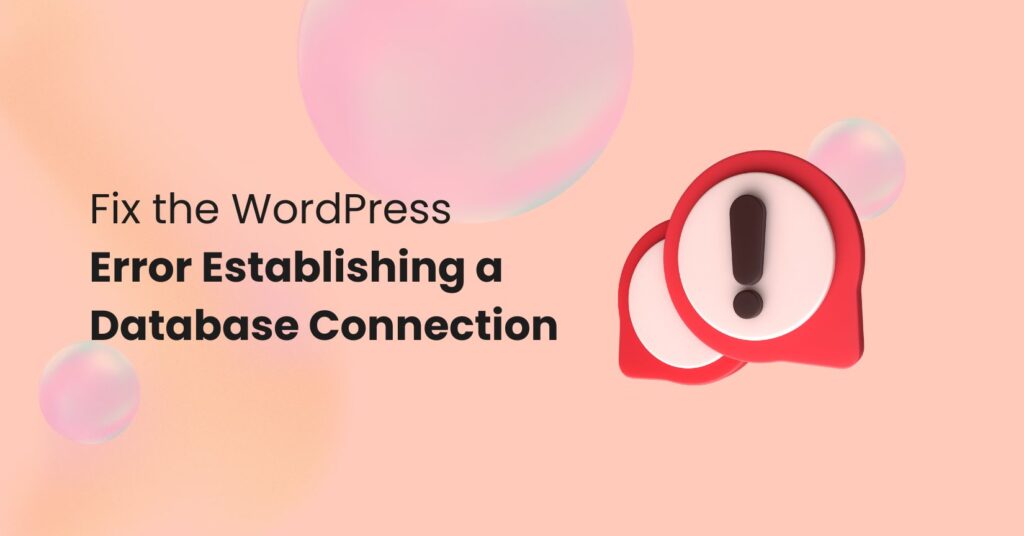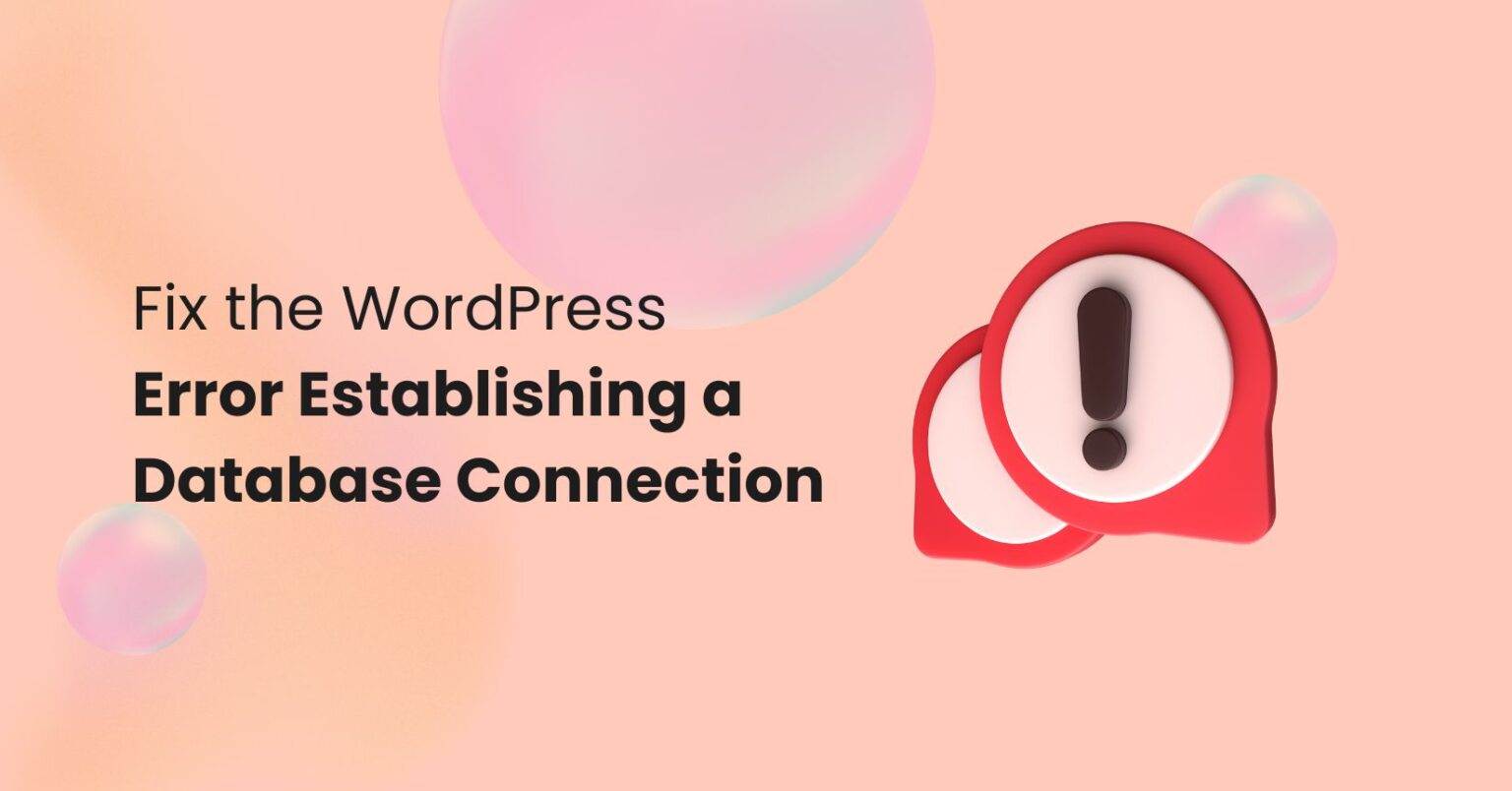When you first see “Error establishing a database connection” on your WordPress site, it’s understandably alarming. This error means WordPress cannot connect to its database—drastically impacting site availability and SEO. This guide walks you through clear, human‑level explanations, practical fixes, and preventative steps, so you can resolve and prevent this error confidently.
What Error Establishing a Database Connection Error Really Means
This error shows up when WordPress attempts to connect to its MySQL database and fails. It isn’t a generic error—but rather indicates a direct breakdown in communication between WordPress and MySQL.

Major reasons include:
- Incorrect database credentials in
wp-config.php - The MySQL server is down or crashed
- Corrupted WordPress database or tables
- Corrupted core files, plugins or themes
- Server resource limits or intermittent issues
Step 1: Check & Fix Database Credentials for Error Establishing a Database Connection
Mistyped or mismatched credentials are the most common cause.
- Open
wp-config.phpin your site root. - Locate and verify these values:
define('DB_NAME', 'your_database_name'); define('DB_USER', 'your_db_username'); define('DB_PASSWORD', 'your_db_password'); define('DB_HOST', 'localhost'); // or your host - Compare values with your hosting panel (cPanel/Plesk) under MySQL Databases or via SSH.
- Update credentials in the file if needed, save, then reload your site.
If mismatch caused the issue, it should disappear now.
Step 2: Confirm MySQL Server is Running
Even correct credentials can’t help if the database server isn’t active.
- Use SSH or hosting tools to check MySQL status:
systemctl status mysql - For shared hosting, log into cPanel → MySQL Databases, or contact support.
If the server is overloaded or crashed, restarting MySQL usually resolves the issue (bobcares.com).
In cloud environments, sometimes disk space is full. Increasing allocated space often fixes this .
Step 3: Repair a Corrupted Database
If WordPress cannot read tables, you’ll often see this error even when logged into admin.
Option A: Use WordPress repair mode
Add to wp-config.php:
define('WP_ALLOW_REPAIR', true);
Then, open in browser:
https://yourdomain.com/wp-admin/maint/repair.php
Choose “Repair Database” or “Repair & Optimize.” After repair, remove the line to prevent unauthorized use.
Option B: Use phpMyAdmin
- Login, select your database.
- Tick all tables and choose Repair table.
- Run repair and test your site .
Option C: Use WP‑CLI
Run this SSH command:
wp db repair
Then clear cache and verify site functionality .
Step 4: Deactivate Faulty Plugins or Themes
Sometimes a misbehaving plugin or theme interrupts database access.
- If admin access works, go to Plugins → deactivate one by one.
- If admin is down, rename
/wp-content/plugins/via FTP to deactivate all thread blocks. - If the error disappears, reactivate one plugin at a time to identify the culprit.
- Repeat the process for active themes — swap to a default theme for testing.
Faulty themes/plugins are less common causes—but worth checking.
Step 5: Replace Corrupted Core Files
Corrupted WordPress core files—possibly from hacks or failed updates—can break critical database functions.
To fix:
- Download the same version of WordPress from wordpress.org.
- Remove
wp-contentfolder andwp-config-sample.php. - Upload the fresh core files to your server, overwriting existing ones.
- Clear cache and revisit the site (kinsta.com).
Alternatively, use WP-CLI:
wp core download --skip-content --force
This installs fresh core files without overwriting themes/styles.
Step 6: Check for Low System Resources
High traffic or limited host plans can exhaust MySQL connections—triggering intermittent errors.
- Look at MySQL process list during peak hours.
- Use caching plugins (e.g., W3 Total Cache, Redis) to reduce database load.
- Consider upgrading hosting, switching from shared to VPS or managed WordPress hosting.
Step 7: Contact Hosting Provider
If all else fails:
- Ask if the database server has experienced outages.
- Inquire about connection limits, storage quotas, or security lockdowns.
Managed hosting panels often allow quick access to logs and controlled restarts .
Preventative Tips & Best Practices
After recovery, implement these to avoid future disruptions:
- Back up regularly—use UpdraftPlus, BlogVault, or similar tools.
- Keep WordPress, plugins, and themes updated—outdated files are a common source of database corruption.
- Monitor server resources—watch disk usage, CPU, and memory; scale when needed .
- Use reliable hosting—choose reputable providers that offer stable MySQL setups.
- Implement caching—page and object caching drastically reduce database load.
Real-World Fixes from Community
From r/WordPress and r/docker:
“If your local environment is set up with Xampp or Wamp make sure your MySQL is turned on along with apache.” (reddit.com)
“The issue turned out to be I was using 100% of available storage space … increased it and rebooted … and all issues went away.” (reddit.com)
“First thing I would try now is restarting the MySQL/MariaDB instance … delete all files … restore files and database from backup.” (reddit.com)
These examples confirm that simple fixes—starting services, freeing disk space, rolling back to backups—often solve the problem.
Summary Table: Quick Troubleshooting
| Problem | Solution |
|---|---|
| Wrong credentials | Correct DB settings in wp-config.php |
| DB server down | Restart MySQL, check hosting panel |
| Corrupted tables | Repair via WP, phpMyAdmin or WP-CLI |
| Faulty plugins/themes | Deactivate one by one |
| Core file corruption | Reupload core WordPress files |
| Server resource limits | Enable caching, upgrade hosting |
| Persistent issues | Contact hosting provider |
Read Also: How to Become a WordPress Developer in 2025
Final Thoughts
Experiencing this error can be unnerving—but it’s usually fixable with a systematic approach. Always start with credentials and server health, then move through database repairs and file integrity checks. After restoring functionality, focus on prevention: backups, updates, caching, and monitoring.
By fully understanding and acting on these steps, you’ll not only fix the immediate issue but also build a WordPress setup that is resilient, reliable, and ready for 2025 and beyond.



